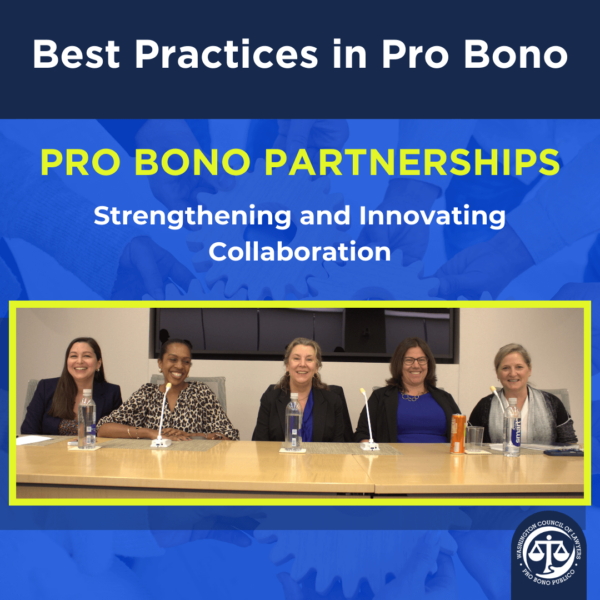
Recap: Best Practices in Pro Bono: Pro Bono Partnerships: Strengthening and Innovating Collaboration
On Wednesday, October 30 we convened for Best Practices in Pro Bono: Pro Bono Partnerships: Strengthening and Innovating Collaboration. The panel was moderated by Jen Masi, Pro Bono Director at Children’s Law Center, who was joined by our panelists:
- Rwanda Campbell, Pro Bono Manager, Arnold & Porter
- Lisa Dewey, Pro Bono Partner, DLA Piper
- Jen Tschirch, Director, Pro Bono Programs, Georgetown Law
- Kaitlin Banner, Deputy Legal Director, Washington Lawyers’ Committee for Civil Rights and Urban Affairs
We began by discussing the many positives of pro bono partnerships. Both panelists and audience members shared experiences that underscored how collaborations between law firms, law schools, and legal service providers (LSPs) amplify the impact we can make for our communities. For law firms, pro bono work is a key source of professional development. Associates, often engaging directly with clients for the first time, build skills in client interviewing, trauma-informed lawyering, and other areas they are passionate about. This hands-on experience not only strengthens their legal acumen but also instills a lasting commitment to service.
For LSPs, pro bono partnerships enhance organizational capacity. Many shared that volunteer attorneys often continue their support beyond initial clinic services, taking on cases because of their strong connection to the client and their commitment to help see cases through to resolution. Law firms contribute invaluable resources—such as research capabilities and a wide range of legal skills—which can significantly improve case outcomes in family, immigration, and other complex legal matters.
Law students also benefit tremendously from pro bono work. These early experiences provide insights into real-world legal issues, giving them both immediate and long-term skills they carry forward. Panelists shared the story of a Georgetown Law graduate who proudly displayed his pro bono certificate in his office alongside his firm’s pro bono accolades, exemplifying the pride and commitment that pro bono service can foster early in one’s career.
After covering the positives, we turned to some common pain points in pro bono partnerships, particularly around communication and expectation-setting. The panel emphasized the need for honesty in setting expectations from the start. LSPs often hesitate to ask for too much support from firms, since they are providing their services for free. Conversely, firms seeking to lessen the LSP’s workload may avoid frequent communication to not be burdensome. However, the consensus was clear: regular communication is essential for effective collaboration.
One illustrative example was the importance of cc’ing firm pro bono counsel on case check-ins. LSPs, wanting to avoid adding pressure on the volunteer attorney, may avoid involving the firm’s pro bono counsel. However, the firm often benefits from being kept in the loop, as it helps them monitor case progress and identify needed support. A straightforward solution discussed was to standardize cc’ing pro bono counsel to create transparency and ease any perceived pressure on both sides.
Other challenges in pro bono partnerships were also addressed:
- Mentoring and Co-Counseling: Different workplace cultures can create misunderstandings in responsiveness and task delegation. Some associates expect rapid email responses, while LSPs may need longer to reply. Clear communication about timelines and mentoring expectations from the outset can bridge these gaps.
- Role Clarity: Firms sometimes form pro bono teams without clarifying roles, leading to confusion about who should take lead. It is helpful for LSPs to know the team dynamics to ensure efficient communication.
- Resource Allocation: Short clinics and limited-scope representations are increasingly popular with law firms but can create strain for LSPs, which often need long-term support. Innovative solutions can help. For instance, one firm developed a clinic for Employment Authorization Document applications, originally part of broader immigration representation, making it manageable for both the firm and the LSP.
- Staff Transitions: Firms often have succession plans for billable work but lack them for pro bono cases, leading to staffing gaps when an attorney leaves. At this stage, some pro bono counsel have taken it upon themselves to get involved with that succession conversation so that no pro bono cases go unstaffed. However, with no formal plan the burden to identify unexpected staffing needs for a case can fall on the LSP. Generally, greater communication regarding sufficient ongoing staffing for pro bono work is needed both for the law firms and the LSPs to ensure continual support for the clients being served.
- Fear of Mistakes: Associates often feel anxious about potential errors in areas where they lack expertise, fearing their mistakes could severely impact clients’ lives. Openly addressing these concerns early on allows for mentoring support from LSPs, reassuring attorneys and helping them navigate unfamiliar areas of law.
Ultimately, the conversation emphasized that communication is the cornerstone of successful pro bono partnerships. Many in attendance joked that these partnerships resemble a marriage—relying on continual communication to navigate challenges. Innovation in pro bono work doesn’t always require sweeping changes; sometimes, small adjustments have significant effects.
We thank our panelists and audience members for contributing to such a rich discussion and look forward to our next Best Practices event!






